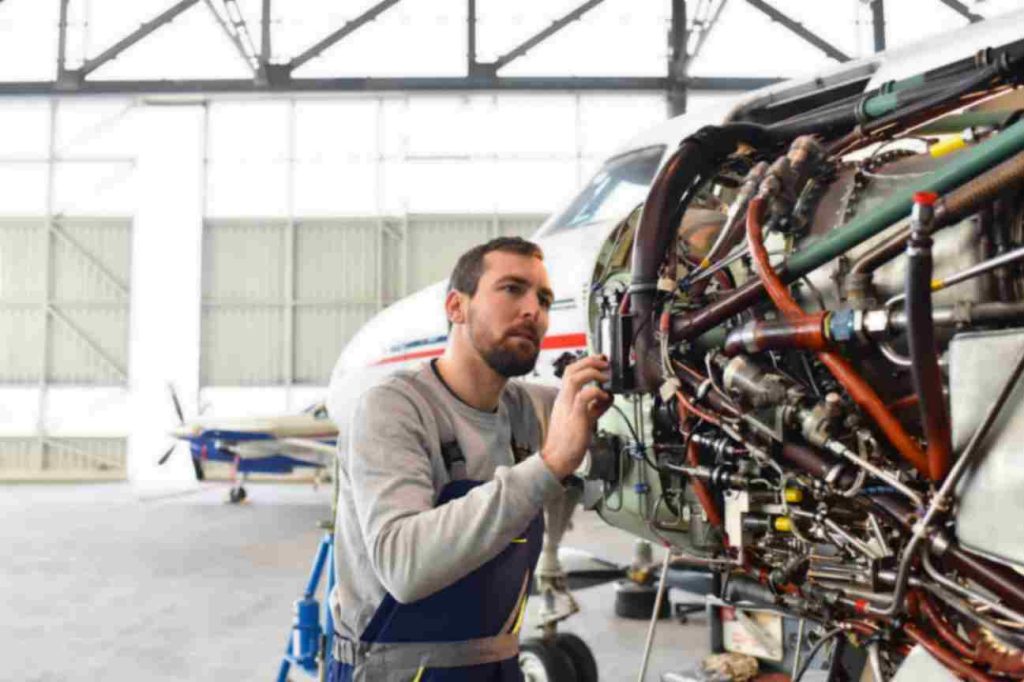Find Apprenticeship Programs
Search for Apprenticeships

FEATURED APPRENTICESHIPS
Explore Apprenticeships
Learn About Apprenticeships
Become an Apprentice
What is an Apprenticeship?

An apprenticeship is a paid job where an individual, called an apprentice, works alongside a skilled professional to learn a specific trade or skill. Apprenticeships are a combination of paid on-the-job training and classroom instruction. An apprenticeship is a mutual commitment between the employer and the apprentice. Apprenticeships have been traditionally offered in building and construction trades, including electrician, carpentry, and plumbing. Modern apprenticeships are in almost every career area, including business, software engineering, culinary, tattoo artistry, agriculture, healthcare, cybersecurity, pharmacy technician, engine mechanic, insurance, financial services, education, and robotics.
In fact, there are over 1000 career areas approved for apprenticeships, with more added all the time. Apprenticeships provide hands-on experience, mentorship, and a pathway to gain practical skills and knowledge in a particular field. Apprenticeships have a defined duration, and upon completion, the apprentice is usually awarded a certification or qualification.
- Gain valuable skills and experience in a specific trade or career path.
- Receive hands-on training and mentorship from experienced professionals.
- Increase job readiness and enhance employability.
- Get paid while you learn a career.
- Opportunity for career advancement within a company or industry.
- Learn in a structured and supportive environment.
- Earn recognized certifications or qualifications.

The Different Types of Apprenticeships
Registered Apprenticeship
An Apprenticeship is job that pays you while you learn a trade or career skills. Only apprenticeships that are evaluated and approved by a state or federal Department of Labor can be called a Registered Apprenticeship. Registered Apprenticeships last anywhere from 1 to 6 years. They provide paid on-the-job training combined with related classroom instruction. Registered Apprenticeships offer career paths with advancement potential. Some apprenticeships earn college credit at the same time.
Pre-Apprenticeship
A Pre-Apprenticeship is a program that prepares an individual to succeed in a registered apprenticeship. These programs have a partnership with an apprenticeship employer. A pre-apprenticeship provides the necessary foundation skills in math, English, and work readiness, basic job training, and exposure to the industry. They are sometimes paid, but rarely charge tuition or fees.
Youth Apprenticeship
Youth Apprentices split time between school and paid career training. Youth Apprenticeships, sometimes called High School Apprenticeships, are designed for 16 to 24 year-old students, currently enrolled in secondary education or pursuing a high school equivalency. Youth apprenticeships combine technical classroom instruction with work experience. They provide the foundation to choose multiple career pathways: enroll in college, begin employment, or a combination.
Where To Find Apprenticeships
Find employers hiring for paid, free apprenticeship program jobs in the United States
Research
Start by exploring apprenticeship opportunities in fields that interest you. Search job sites including Apprenticeship.com. Visit a local American Job Center. If you are in high school, consult with your guidance counselor.
Industry Associations and Unions
Many industries have their own websites that advertise available apprenticeships. For example, the International Brotherhood of Electrical Workers offers electrical apprenticeships, while the National Association of Home Builders has apprenticeship programs for carpentry, masonry, and plumbing. The National Institute of Standards and Technology offers the NICE Cybersecurity Apprenticeship Program Finder.
Government Websites
The U.S. Department of Labor provides information on registered apprenticeships and apprenticeship sponsors across the country. You can also visit state government websites for information on available apprenticeships.
Military
There are specific apprenticeship opportunities for those in the Military. The US Military has its own apprenticeship program for current and former enlisted members.
When searching for apprenticeship opportunities, be sure to research the specific requirements and timelines of each program, also check for application deadlines and prerequisites.
Apprenticeship Frequently Asked Questions (FAQ)
Q: Are apprenticeships only offered in the building trades such as plumbers, carpenters and electricians?
A: Apprenticeships are not limited to the building trades. The building trades do offer apprenticeships, but so do many other career areas. Apprenticeships are now offered in career fields including healthcare, information technology, AI, business, finance, the arts, media, hospitality, and many more.Q: Are apprenticeships available to people of all ages?
A: Most apprentices are 18 - 34 years old. While there is a minimum age requirement of 16 years old, there typically isn't an upper age limit.
Q: Is it true you will never go to college if you become an apprentice?
A: No, in fact, some apprenticeship opportunities include on-the-job learning and related training instruction that earns credit towards 2- and 4-year college degrees.
Q: Are skills learned during an apprenticeship specific to one employer?
A: No, you learn transferable skills during an apprenticeship. If you complete a Registered Apprenticeship, you will earn a credential that is recognized by the industry.
Q: Are there apprenticeship programs in high-growth industries?
A:Yes, apprenticeship spans more than 1,000 occupations including careers in health care, cybersecurity, information technology, teaching, and energy.
Q: How long are apprenticeship programs?
A: The length of an apprenticeship program can vary from 1 - 6 years depending on the complexity of the occupation, industry, and the type of program.
Q: Do I get paid as an apprentice?
A: Yes, apprenticeships are jobs that pay a wage. The wage varies depending on factors such as the field, location, and level of experience. In some cases, the wage may be lower at the start of the apprenticeship but gradually increases as the apprentice gains more skills and knowledge. Additionally, some apprenticeship programs may include benefits such as healthcare, retirement contributions, and other employer-provided benefits.
Q: Is it true that only people who don't do well in school become apprentices?
A: No, apprenticeships are for individuals of all academic abilities who want to gain professional skills. They are an option for people who prefer a more hands-on approach to learning. Apprenticeships are an alternative path to a career. It is a myth that only low achieving students become apprentices.
Q: Will you get stuck doing one job forever if you do an apprenticeship?
A: No, apprenticeships, like any other entry level opportunity could be the pathway to career advancement. Apprenticeships can lead to different positions.
Q: Are there inclusive and accessible apprenticeships?
A: A: Yes, Apprenticeship is a workforce solution that actively promotes diversity and inclusion in the workplace - including people with and without disabilities, people of color, women, ex-offenders, and veterans. An inclusive apprenticeship program is designed to be accessible to and inclusive of all candidates. As the U.S. expands apprenticeship training nationally, a diverse workplace helps businesses access all our nation's talent. Inclusive apprenticeship programs provide opportunities for people with disabilities, including individuals with cognitive, neurological, physical, mental health, and sensory disabilities, to gain credentials and skills to succeed in their desired careers. Visit the Partnership on Inclusive Apprenticeship (PIA) to learn more about advancing your career through inclusive apprenticeship, including information on how to become an apprentice, disclosing a disability, and requesting accommodations. Many apprenticeship programs actively promote diversity and inclusion in the workplace. Apprenticeships can be a valuable pathway for minorities to enter skilled trades and gain access to well-paying careers. Efforts to promote diversity and inclusion in apprenticeship programs are ongoing, aiming to create more equitable access to these opportunities. In 2016 the Department of Labor released updated Equal Employment Opportunity (EEO) regulations for Registered Apprenticeship Programs to help businesses reach a larger and more diverse pool of workers.
Apprenticeships vs. Internships
There are some big differences between apprenticeships and internships.
An apprenticeship is a job that combines on-the-job training with classroom instruction or online learning. Apprenticeships typically involve a longer duration of training and a more structured career development track, compared to internships.
An internship is a temporary work experience that provides an opportunity to gain practical experience in a particular industry or field, typically related to their career interests. Interns are usually not considered full-time employees and may receive academic credit if they are paid for their work. Internships are often shorter in duration and may not offer the same level of training and mentorship as apprenticeships.
Apprenticeships focus on teaching specific job skills, while internships offer an overview of a profession.
Apprenticeship vs. College Degree
When considering whether to pursue an apprenticeship or attend college, it's important to assess your career objectives, and interests. Some apprentices go on to obtain a college degree after they complete their training. Here are some factors to consider:
Practical Experience: Apprenticeships provide hands-on, practical training in a specific trade or profession, allowing individuals to directly apply their skills in an actual job. In contrast, college education often focuses on theoretical knowledge and often does not offer the same level of practical experience.
Career Readiness: Apprenticeships are designed to equip individuals with job-specific skills and lead to immediate employment opportunities. By completing an apprenticeship, individuals can potentially secure a stable job and earn a livable wage sooner than their college-educated counterparts. However, it's important to note that certain professions may require a college degree for advanced roles or higher salaries.
Education and Credentialing: A college education offers the opportunity to develop critical thinking, research, and communication skills, along with a broader knowledge base that can be transferred across various industries. A college degree may be required if graduate school is necessary to obtain an industry credential.
Time and Cost: Apprenticeships are sometimes shorter in duration compared to traditional college programs. They are jobs that allow individuals to enter the workforce and start earning sooner without large amounts of debt. College education often requires a longer time commitment, typically spanning multiple years. Additionally, the cost of college tuition should be considered.
Personal Learning Style: Some individuals thrive in a hands-on learning environment, while others prefer a more theoretical and academic setting. Assessing your learning preferences can help determine whether an apprenticeship or college education aligns better with your preferred learning style.













